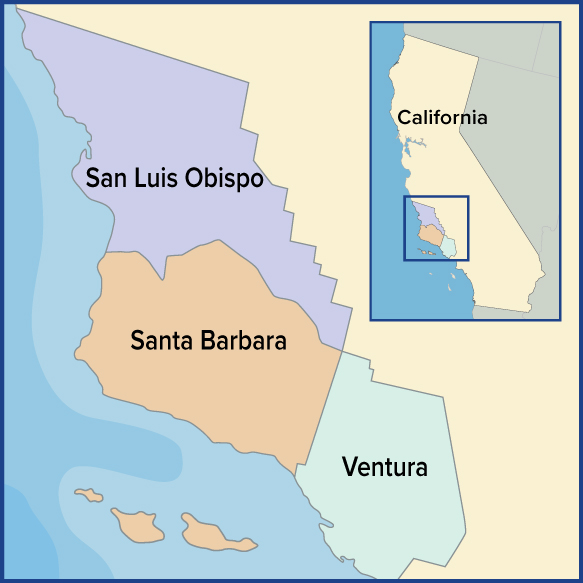New lead photo

Photo by Ken Hughes
Dr. Sam Dover, left, injects a sedative in an adult female sea lion poisoned by domoic acid that stranded in Santa Barbara Harbor in June 2023. Head of the Channel Islands Marine & Wildlife Institute, Dover is aided by Dr. David Mendelson, a retired physician and volunteer.
 Listen to this story.
Listen to this story.
While vacationing in California last summer, Richard Novak and his family spotted a dead sea lion on the beach near Santa Barbara. That same day, they saw a second sea lion dying and a third looking disoriented. Novak reached out to area rescue groups, making contact with the Channel Islands Marine & Wildlife Institute (CIMWI), which, he learned, had become woefully familiar with calls like his.
The sea lions, the staff told him, were probably victims of domoic acid poisoning, a serious and often fatal condition caused by ingesting a toxin produced by certain microalgae. There is no antidote for domoic acid poisoning; treatment is limited to supportive care.
Then Novak asked a question that was less familiar to staff: "What can I do?"
Novak isn't your everyday citizen. He is a bioengineer and founder of a pharmaceutical company.
The CIMWI team connected him with their group's founder, Dr. Sam Dover, a veterinarian. Three days later, the two men were meeting in person to brainstorm a solution.
Now they are at the forefront of efforts to find meaningful treatment for a condition that is killing a growing number of sea lions off the coast of California every year.
'They look like they're drunk'
Dover founded CIMWI in 2006 to provide marine mammal rescue, rehabilitation, research and education. The nonprofit is one of several organizations on the Pacific Coast equipped to deal with stranded marine mammals. As such, its team is acutely acquainted with the striking signs of toxic algae poisoning in sea lions.
"They look like they're drunk," said Dr. Jake Bryan, a CIMWI veterinarian. "They're kind of walking on the beach, very wobbly. They don't really seem like they know where they are. Or they're just having ... seizure after seizure."
Other signs of poisoning include lethargy, confusion, head lolling and foaming at the mouth. The toxin attacks the brain and heart, causing seizures and heart failure. Domoic acid toxicosis can kill neurons (neuronal necrosis), resulting in permanent nerve damage.
Domoic acid is produced by certain diatoms, or microalgae, of the genus Pseudo-nitzschia. Marine filter feeders such as shellfish, sardines and anchovies consume the algae. During algal blooms, domoic acid levels build up in the filter feeders, which, in turn, are consumed by fish-eating birds and marine mammals. Domoic acid is toxic to the birds and mammals.
(People who eat seafood in which domoic acid has accumulated also are susceptible. Typically associated with consuming contaminated shellfish, the condition in humans is called amnesic shellfish poisoning.)
Among marine mammals that have been found with domoic acid toxicosis, including dolphins and seals, sea lions appear to be more susceptible and likelier to show up on the beach sick. A possible reason, Bryan said, is that sea lions tend to feed on animals that occupy different depths from seals. "Seals dive deeper to feed on animals that aren't exposed to domoic acid, whereas sea lions feed on fish that are," he explained.
Poisonings can be acute or chronic. Acute toxicosis immediately follows ingestion and absorption of domoic acid, whereas chronic toxicosis results from either repeated low-level exposure or from long-lasting effects of past exposure, according to a study published in 2023 led by researchers at the Marine Mammal Center in Sausalito, California. The study states that typically, clinical signs of acute cases either resolve within seven days "once [domoic acid] is cleared from the body" or progress to "a chronic epileptic state or mortality."
No comprehensive data on mortality rates is available, but information from specific incidents indicates that death occurs frequently, especially in animals that are very sick by the time they receive veterinary care. For example, during an event in 1998, of 70 California sea lions taken into facilities for care, or "rescued," nearly 70% died, according to a report in December 2000 by the National Oceanic and Atmospheric Administration (NOAA).
Supportive care is all that is available for veterinary patients with domoic acid toxicosis. They are provided with nontoxic foods and fluids and may be given anti-seizure medications.
Under NOAA guidelines for release, affected animals should be returned to the wild when there is a "likelihood of survival and a lack of risk to the health of wild marine mammals." Still, once an animal has been poisoned, it is more susceptible to repeated poisoning and may strand again, according to multiple sources. And so a futile cycle emerges.
CIMWI and the Marine Mammal Center are two of more than 30 members of the West Coast Marine Mammal Stranding Network coordinated by NOAA. The network covers Washington, Oregon and California. The Marine Mammal Center tends to a 600-mile stretch of coastline from Mendocino County to San Luis Obispo County. CIMWI covers the 155 miles of coastline in Santa Barbara and Ventura counties.
Updated central/southern coast map

Map by Tamara Rees
The central and southern coast counties of San Luis Obispo, Santa Barbara and Ventura were a hotspot in California last year for marine mammal strandings driven by toxic algae poisoning.
A worsening problem?
The domoic acid poisoning episode of 1998 was the first documented instance of its effect on marine mammals on the California coast. In that year, more than 100 sea lions stranded.
During the next 20 or so years, intense outbreaks generally occurred every three to five years, usually in spring. Since 2021, they've happened every year and lasted longer than usual.
From July to September last year, Marine Mammal Center responders handled more than 200 apparent cases of domoic acid toxicosis in sea lions in San Luis Obispo County alone, according to Giancarlo Rulli, a center spokesperson. By comparison, the center usually responds to about 80 cases during a full year, he said.
The central and southern coasts were a hotspot. CIMWI, which covers the two counties south of San Luis Obispo County, responded to more than 500 cases in 2024.
"The last three years have not been normal," Dover said, noting that at peak activity, the team might respond to one stranded animal only to "look down the beach and [see that] there's five more having seizures."
After what feels like a never-ending season, he said, "[Y]ou take a breather, and less than a year later, it pops up again."
There's no clear answer to why outbreaks seem to be happening more frequently and lasting longer. The prevailing understanding is that warmer waters support harmful algal blooms. But Clarissa Anderson, an oceanographer and the director of the Southern California Coastal Ocean Observing System, said her organization's monitoring data suggests the answer is more complex.
Anderson noted that El Niño, a climatic pattern in which sea surface temperatures rise in the eastern Pacific Ocean, and other marine heatwaves do not seem to correlate with increased incidence of domoic acid poisoning.
In fact, as a NOAA article in August noted, "upwelling," in which cold water carrying nutrients from the ocean's depths rises to the surface, fuels algae blooms. However, Anderson said monitoring from the ocean observing system indicates that upwelling during the past three years was not out of the ordinary. "We do think upwelling caused the blooms," she said, "but we don't see anomalously strong upwelling that explains why" cases of domoic acid toxicosis have been seen more frequently and for a longer period.
Nevertheless, she acknowledged that something odd appears to be going on. "It does seem out of the ordinary to have three consecutive years of large stranding events, particularly at the end of the summer," she said.
The rising frequency and seriousness of stranding episodes have veterinarians looking for a way to better help their marine patients.
Searching for a cure
Novak's company, Unravel Biosciences, uses an artificial intelligence-driven tool to identify existing drugs that may be effective treatments for human diseases. The Massachusetts-based company currently has three drugs in early clinical testing, with two aimed at genetic disorders, according to its website.
After he and Dover connected in August, Novak pitched a partnership to pursue a treatment for domoic acid poisoning in marine mammals. It came together in short order. Today, the partnership consists of CIMWI, Unravel and Zymo Research, a California biotech company. CIMWI's role is to collect samples of nasal fluids and blood samples from affected and unaffected sea lions alike. Zymo's part is to extract genetic information from the samples.
Unravel enters the genetic information into its proprietary tool "to predict the most promising drug candidates to treat [domoic acid] poisoning," according to a press release from Zymo in October.
Once candidates are identified, the baton will be handed back to CIMWI "to develop treatment strategies aimed at increasing [sea lions'] chances of survival and release into the wild."
Novak told VIN News that the team "hope[s] to be fully ready for the next onslaught of cases that will inevitably come as the water warms up" this year. "The goal is to develop a rapidly acting, beach-injectable countermeasure for the neurotoxin to at least enable the animals to receive proper care in a more advanced veterinary setting than what can be provided on a beach in a rapid response," Novak said.
Zymo and Unravel are contributing their efforts free of charge, Dover said. The research is in its early stages, and there certainly will be an aspect of trial and error, said Bryan, who heads the project for CIMWI, but he is "cautiously hopeful."
The Marine Mammal Center also is researching treatments. Rulli said its veterinarians are testing various combinations and dosages of the antioxidant alpha lipoic acid, anti-inflammatory drugs and anti-seizure drugs.
For all involved, better options for care can't come soon enough.
Noting that euthanasia is often the only answer for a patient that has permanent nerve damage, Rulli said he is acutely aware of the Marine Mammal Center team's worsening compassion fatigue.
Smaller outfits like the CIMWI are stretched financially as well as emotionally. "We are one of the smallest rehabilitation organizations off the coast of California, yet we are the organization dealing with the most [cases]," Bryan said.
As Dover sees it, the status quo isn't acceptable. "Once you realize that there's not much you can do, then [the question is] what do we do differently, collectively?" he said. "We didn't get in this business to euthanize animals."